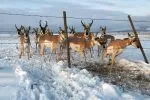USDA Commits to Big Game Conservation Partnership with the State of Wyoming: Initial Investments Forthcoming


CODY, Wyo., May 20, 2022 – U.S. Department of Agriculture (USDA) Under Secretary Robert Bonnie announced a new partnership that uses diverse Farm Bill investments to support voluntary conservation of private working lands and migratory big game populations in Wyoming. Bonnie made the announcement at the University of Wyoming’s Yellowstone National Park 150th Anniversary Symposium. Using lessons learned from this pilot, USDA seeks to scale up this model across the West as part of President Biden’s commitment to support voluntary, locally-led conservation efforts to reach the administration’s national conservation goals.
“Conserving America’s most iconic wildlife and wildlife migration corridors depends on the conservation of private working lands and tribal lands through voluntary, collaborative incentives that reward farmers, ranchers and forest owners for stewardship of their lands,” said Bonnie, USDA’s Under Secretary for Farm Production and Conservation. “Today’s announcement results from consultation with the State of Wyoming and local stakeholders to create new and enhanced opportunities through USDA’s conservation programs to expand our work with farmers, ranchers and forest landowners to conserve wildlife and migration corridors and to keep working lands working.”
“Wyoming leads the nation in our approaches to conserving big game and their movements. We’ve done that with strong landowner partnerships and an acknowledgement that habitat conservation can be done on multi-use landscapes,” said Brian Nesvik, Director of the Wyoming Game and Fish Department. “Private landowners provide key habitat for wildlife seen in Yellowstone National Park. Offering voluntary funding opportunities to landowners to maintain this valuable space for wildlife is a recognition of their role in conservation.”
USDA participated in extensive engagement and listening sessions with stakeholders throughout Wyoming and developed this pilot in response to their feedback. Those listening sessions helped guide the project’s concepts and principles: recognition of the large scale of this issue in key landscapes, coordination with state agencies, consistency with state policy and direction and support of existing partnerships wherever possible.
The pilot will take a systems approach to voluntary conservation and draw on several USDA programs, including the Grassland Conservation Reserve Program (Grassland CRP), Environmental Quality Incentives Program (EQIP), the Regional Conservation Partnership Program (RCPP) and the Agricultural Conservation Easements Program (ACEP) to provide financial and technical assistance for landowners who want to participate. USDA is committing an initial $15 million in investment through EQIP and ACEP for Wyoming, in addition to the rental payments that will go to producers who enroll in Grasslands CRP. There are three distinct conservation areas that USDA will invest in using these voluntary and incentive-based programs. All are designed to help willing landowners and their partners conserve private lands for the benefit of migratory big game populations. They include:
- Agricultural Land Protection – Preventing the conversion of private working lands that provide habitat and other values for migratory big game populations to alternative land uses not compatible with big game migrations. Specifically, this would include preventing actions like residential subdivision, mining and development of commercial wind and solar facilities on private lands. Additional resources will be provided to Wyoming for Agricultural Land Easements through the ACEP (ACEP-ALE) for this effort, as well as prioritization of big game conservation through RCPP.
- Restoration, Enhancement and Management – Restoring and managing working lands to provide a variety of healthy habitats migrating animals need to meet their life history requirements. Habitat quality can be improved in many ways including but not limited to the control of invasive species, restoration of degraded aspens, removal of encroached woodlands and restoration of wet meadows. Ensuring compatibility with fences used for managing working lands and migrating animals is also a top priority. Today, USDA is announcing an additional $5 million in FY22 resources through the EQIP for Wyoming to specifically support these needs. These resources are a significant addition to the State’s current FY22 EQIP allocation of over $16 million.
- Conservation Leases – Managing working lands in a way that ensures the resiliency of the desired habitat conditions is extremely important to migrating big game as they rely upon healthy lands to meet their diverse seasonal habitat needs. Providing annual financial incentives to landowners through a conservation lease can help encourage the long-term management that results in resiliency. The 10- to 15-year contracts through the Grassland CRP are being used to fulfill this need. To date, USDA has committed $32.3 million ($2.3 million paid to landowners annually) to conserve over 170,000 acres through Grassland CRP in Wyoming with additional enrollments to be announced from this year’s signup in the coming weeks. For this year’s signup, USDA piloted policy changes to make it easier for producers to access multiple programs. USDA will continue to work with partners to tailor the program to meet the state’s needs before next year’s signup.
This pilot leverages ongoing conservation efforts on working lands, which prioritizes action to further the conservation of wildlife and habitats through the importance of partnerships and local leadership. The work emphasizes a commitment to voluntary, incentive-based approaches; identifies a critical role of private, working lands; and stresses the importance of supporting state, tribal, and landowners to advance their conservation priorities.
Working Lands and Wildlife
This effort builds on USDA’s Natural Resources Conservation Service’s (NRCS) Working Lands for Wildlife approach, which has enabled more than 8400 producers across the United States to conserve 12 million acres of prime wildlife habitat since 2010. This approach has had ample success in the West, where it has focused on removing invasive weeds and invading conifers, reducing wildfire risk, and protecting wetlands as well as agricultural lands from exurban development. Resulting conservation actions played a key role in the no-list decisions for the greater sage-grouse, Bi-State sage-grouse, and New England cottontail as well as the delisting of the Louisiana black bear. These efforts have recently been expanded through the first biome-scale frameworks for wildlife conservation in the Great Plains grasslands, western sagebrush country, and for the Central and Eastern grasslands and savannas within 25 states in the northern bobwhite range. This big game special project similarly strategically focuses Farm Bill resources to conserve working lands that benefit both wildlife and people.

